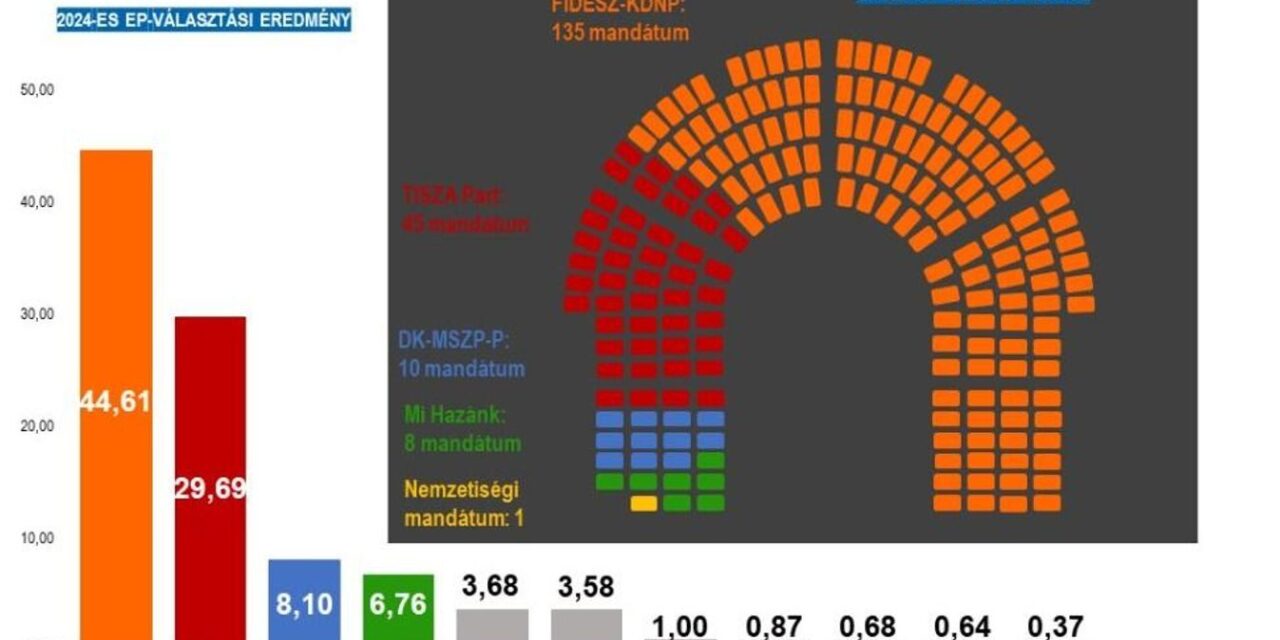Once again, the governing parties would have a large majority if the results of Sunday's election were projected on parliamentary mandates.
The Fidesz-KDNP won the European Parliament (EP) elections with 44.61 percent of the votes, with this performance it could have obtained two-thirds of the parliamentary mandates (135 mandates) in a parliamentary election, the Nézőpont Institute announced on Monday.
Compared to the expectations at the beginning of the year, the Gyurcsány coalition (8.1 percent), which underperformed, as well as the Tisza Party (29.69 percent) and Mi Hazánk Mozgalom (6.76 percent), which entered the European Parliament as newcomers, did not have the EP result for the change of government, nor for the It would not be enough to break a two-thirds ruling party majority, reads the analysis of Nézőpont, which also mentions that several opposition leaders have made early parliamentary elections a stake in Sunday's EP elections: Klára Dobrev in the event of Fidesz's defeat, while Péter Magyar is Fidesz's possible 40 percent he mentioned the need for early elections in connection with his results.
Although none of the expectations were fulfilled, the Nézőpont Institute was curious about the results of the European Parliament elections of each party, which parliamentary proportions would have been in a parliamentary election.
The research institute reminds that the European Parliament elections are held in a purely proportional electoral system, therefore the result achieved by the governing parties in this would have meant an even greater victory in the parliamentary elections that also mixed majority elements.
Based on the results of the EP election divided into national individual constituencies
the Fidesz-KDNP would have won not only the domestic list competition, but also 96 parliamentary individual constituency mandates, the analysis adds.
During Nézőpont's model calculation, it duplicated the votes cast for the parties' EP list, and it started from the assumption that citizens vote individually for the candidate of the same party whose list, so the calculation also took into account the fractional votes of the electoral district for the mandates allocated from the national list.
Based on this, the Fidesz-KDNP could have counted on 39 parliamentary seats from the national list and 96 seats from the individual constituencies, for a total of 135 parliamentary seats, if parliamentary elections had been held on June 9, with which Fidesz, which has been ruling since 2010, could have obtained three quarters of all mandates.
On the other hand, the opposition parties would have suffered an even greater defeat than in 2022: the parties presenting a separate list, assuming that they nominate a separate candidate in each individual parliamentary constituency, would have been able to win in ten individual constituencies based on the distribution of votes received in the EP elections.
Based on their list results and their fractional votes in individual constituencies, Péter Magyar's party could form the largest opposition faction in the parliament (45 seats, 22 percent of all seats), followed by the currently three-party Gyurcsány coalition (10 seats, 5 percent of seats) and Mi Hazánk Movement (8 mandates, 4 percent of the mandates).
In addition, based on the results of the parliamentary elections in 2018 and 2022, they counted on one nationality mandate, which, if not included in their estimate, would have no effect on the two-thirds parliamentary majority of the governing parties.
According to the analysis, the parties that did not enter the EP would not have had a chance to win a parliamentary mandate on their own.
Cover image: This is what the parliamentary horseshoe would look like if parliamentary elections had been held on Sunday
Source: Nezőpont Institute













